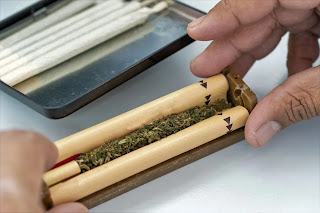Butane Torch Lighters: A Comprehensive Guide to Heat and Safety
 |
| Blazer Big Shot Dab Torch |
The humble lighter has come a long way from the simple flick of a Bic. For those who demand serious, concentrated heat—from searing a crème brûlée to sweating a copper pipe—the butane torch lighter is the undisputed champion. With its intense, adjustable flame and robust design, it's a versatile tool that belongs in many toolboxes and kitchens.
But with great power comes great responsibility. Using a butane torch isn't like lighting a candle; it requires knowledge and respect for safety.
This guide will walk you through everything you need to know about butane torch lighters, from how they work to how to use them safely and effectively.
What Exactly is a Butane Torch Lighter?
At its core, a butane torch lighter is a handheld device that releases pressurized butane gas and ignites it to produce a single, needle-point flame or a larger, fan-shaped flame. Unlike soft-flame lighters, the torch flame is wind-resistant and incredibly hot, often reaching temperatures between 1,300°F and 2,500°F (700°C - 1,370°C).
 |
| whip-it! Ion Lite Torch Lighter |
Key Components:
Fuel Tank: Holds the liquefied butane gas.
Ignition Switch: Usually a piezoelectric mechanism that creates a spark without a flint.
Flame Adjustor: A dial or wheel that controls the gas flow, and thus, the flame size.
Nozzle/Burner: Where the gas is expelled and ignited.
Safety Lock: A crucial feature that prevents accidental ignition.
The Many Uses of a Butane Torch
The applications for this tool are surprisingly diverse:
Culinary Arts: The classic crème brûlée is just the beginning. Use it for blistering peppers, melting cheese on a dish, searing sous-vide meats, toasting meringue, or even lighting your charcoal grill quickly.
Crafting and DIY: Perfect for heat-shrink tubing on electrical wires, soldering electronics, and softening plastics for molding.
Plumbing: Sweating copper pipes for water lines is a primary use for larger torch models.
Cannabis Consumption: Often used for heating dab rigs (nectar collectors, bangers) due to the high, clean heat.
General Tasks: Lighting cigars, campfires, or stubborn candles with ease.
Choosing the Right Torch for the Job
Not all torches are created equal. Consider these factors:
Size & Ergonomics: A small, pen-style torch is great for precise kitchen work or cigars. A larger, pistol-grip torch offers more power and fuel capacity for plumbing or heavy-duty tasks.
Fuel Capacity: Measured in grams (g) or ounces (oz). A larger tank means longer use between refills.
Flame Type & Adjustability: Look for a model with a smooth, easy-to-adjust flame control dial. A focused, pin-point flame is best for detail work, while a broader flame is better for searing.
Ignition Mechanism: Piezoelectric ignition is standard and reliable. Ensure the ignition button feels sturdy.
Build Quality: Metal construction will always outlast plastic, especially around the nozzle which gets extremely hot.
The Golden Rules of Safety

Daily High Club Assorted Clipper Lighter

This is the most important section. A butane torch is a tool, not a toy. Always follow these safety guidelines:
Read the Manual: Every model is different. Familiarize yourself with its specific functions and safety features.
Use High-Quality Butane: This is non-negotiable. Use only triple-refined or higher butane. Cheap, impure fuel will clog the nozzle and render your torch useless. It’s the number one cause of torch failure.
Refuel Properly: Purge the tank beforerefilling. Use a small tool to press the refill valve and release any remaining air and impurities. Then, refill in short, 3-5 second bursts, allowing the gas to settle. This prevents overfilling and ensures a proper flame.
Keep Away from Flammables: Be hyper-aware of your surroundings. Never use a torch near gasoline, paint thinners, aerosol cans, or any other flammable material.
Mind the Surface: Don't use it directly on glass, stone, or other surfaces that can crack from thermal shock. Use a heat-proof base like a crème brûlée dish or a soldering block.
Never Leave Unattended: Always turn the torch off completely and set it down on a non-flammable surface to cool after use.
Store Safely: Store in a cool, dry place, away from direct sunlight and heat sources. Keep it out of reach of children and pets.
Troubleshooting Common Issues
Torch won't light, but you hear gas: The most likely culprit is air in the tank or a clogged nozzle. Purge the tank completely and refill with high-quality butane.
Flame is sputtering or yellow: This indicates incomplete combustion. Your fuel is low, the flame is set too low, or the nozzle is dirty. Refill, adjust the flame higher, and if the problem persists, purge the tank.
Flame won't adjust: The adjustment dial may be stuck or broken. Try moving it gently back and forth. If it's broken, it's time for a new torch.
Final Flame: A Tool of Power and Precision

Original Lighter Leash - 30 Pack

A butane torch lighter unlocks a world of creative and practical possibilities. By choosing the right model, using high-quality fuel, and, most importantly, adhering to strict safety protocols, you can harness its intense heat confidently and effectively.
Whether you're achieving the perfect caramelized sugar crust or fixing a leaky pipe, this powerful little tool is a testament to the fact that sometimes, the best way to get the job done is to turn up the heat—responsibly.
Stay safe, and happy torching!

.webp)
.webp)






.jpg)
.jpg)
Comments
Post a Comment